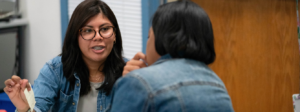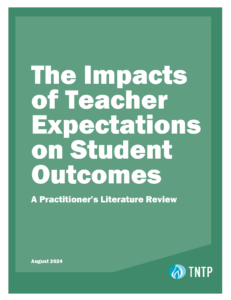Here’s the challenge: you’re running a school in a low-income community, where kids arrive below grade level in reading and math and there’s little evidence of rigorous instruction. You’ve got to balance the budget, and you’re already $300,000 in the red. What stays, and what goes?
That was the question I recently asked 10 aspiring school leaders in Philadelphia. They were educators who had applied to be school leaders through PhillyPLUS, the first alternate-route school leadership program in the city—and the first one for us, too, at TNTP.
We all sat in a room at the district offices, and our candidates debated whether to trim spending on substitutes or professional development. What would teachers and parents say about limits on the copy machine, cutbacks on books and supplies, fewer elective courses for kids to choose from?
This program is a step into the unknown, both for us at TNTP and for the candidates vying for a spot. Though we’ve trained more than 50,000 teachers across the country, worked with administrators on recruitment and evaluations and coached thousands of principals, we’ve never trained new principals before. The need is clear: we know that principals are the weakest link in teacher evaluations, and research also shows that a good leader comprises as much as 25% of a teacher’s effectiveness. Principals also shape instructional school culture, which our research has found has a significant impact on student achievement and whether effective teachers stay on the job.
As a former principal myself, I was struck by our candidates’ energy and focus on kids. They had seen students thrive in their own classrooms, and were ready to make that happen for a whole school. That’s a great starting point. But enthusiasm is just one small part of the equation. Strong judgment, decisiveness, creating a caring culture for students and teachers, and most of all, the ability to be an instructional leader, are critical.
It’s a complex skillset, one that we believe is best mastered by actually placing an aspiring principal in a school, facing many of the same challenges they will face as a leader. So rather than spending their preparation year coming up with a theory of school leadership or developing plans for a hypothetical school, our residents will be managing a team of teachers with the support of mentor principals and hands-on coaching.
This structure may sound familiar, but I see three unique strengths in our program:
- Making graduation count. We have set the bar high, and expect that not everyone will meet it. As with our teacher certification programs, we will measure our residents’ success based on the academic outcomes of the students in their classrooms. And while most folks are focused on getting their entire cohort across the finish line, we will require evidence of a positive impact on student learning before we’ll recommend that you lead a school.
- Focusing on performance management. There’s a lot for principals to learn, but we’ll focus first on teaching them how to manage toward explicit instructional goals and recruit, develop and retain great teachers. Our folks will have to have the guts to communicate necessary feedback based on clear evidence from the classroom, and also be willing to say, “I am inspired by what I see in your classroom, I appreciate the effort you put into it, and I want to keep you here for our kids.”
- Hands-on coaching. A single mentor isn’t enough—our partner principals are already busy running their own schools. They’ll host our residents and serve as exemplars, and also share their insights into the needs of the community and the nuts and bolts of building management. But we’re also providing coaches, to observe and support residents’ development throughout the school day. This will allow principals to continue to do their important jobs, while also giving our residents the constant feedback that they need to grow fast. It’s a pricey strategy, and one that’s not easy to staff, but one that we know has major benefits.
This is not going to be an easy year for our residents—or for us. Together, we are facing long hours, constant challenge and high stakes attached to their performance. But by next summer, our residents will have a year of experience and training, a cohort of like-minded leaders and a playbook of strategies to help teachers and students succeed. As they each step into a new school as its principal, they won’t know everything. But we’ll make sure they’ll be ready to lead.








